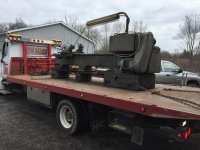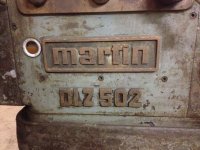Martin,
Over the years I've come to the conclusion that a used machine tool's real value is defined by three aspects;
1. Intrinsic value (Scrap, the value of the metal)
2. Active value, based on the work it is capable of relative to another lathe of similar type and features.
3. Other factors such as brand recognition.
Resell value is the amalgam of all of the above, a nice looking machine will sell for much more than a bad looking one with the same capabilities.
For me the only thing that really matters is whether and how much the lathe will earn. This is the money you can make with it if you use it to it's fullest capabilities, and is also related to when in design history it was made. A modern well engineered gear head lathe made today is essentially the same as any good brand of the last 50 years or even farther back, the last major change was the DRO and that's a common retrofit.
The cream of the crop in manual lathe design I think was the inserted way lathes like the one shown in Tony's site under Martin! The gearhead looks well designed, the ways 58-60 Rc and the only other considerations are the voltage which you have licked, and the leadscrew, if it's an inch leadscrew it will be much more valuable than if it is a metric leadscrew (On this side of the Atlantic).
If the feed box allows metric threading with lever shifting that's huge for lazy people like me, one doesn't have to change pick off gears which is often a tedious dirty job.
What I cannot understand is the value of old flat belt drive lathes. Are people starting museums? Do people so admire the old ways that they are willing to put up with the irritating or even dangerous aspects of them? Leaving planers and shapers out (Because hardly anyone makes them anymore), belt driven machines were built for much less FPM so production should be prorated lower if in a commercial setting. I'm talking about myself too, I have 5 old belt drive lathes(Not being used commercially).
I think people are just afraid they will be scrapped. For the effort of truly restoring an old belt drive lathe most people would be way ahead to buy a new Chinese gearhead lathe, and no, they are not all crap, the commercial quality Chinese lathes are very good quality if you can buy one with a good reputation. (I'm not talking about hobby class lathes as sold by HF etc.)
I'd like to read comments about what I just said about antique machines. Recently an old wood bed lathe from pre 1850 was being discussed here, the OP said he wasn't starting a museum. So, what really is the point? And I'm not suggesting that I'm the arbitrator of who does what, I'm saying this for curiosity's sake. If people are going to use antique machines why are they doing it? Justification is in the eye of the restorer.
But as to the Martin lathe, if it's as in the website, it's as capable as the best lathes made today once you clean it up and put a DRO on it, so, assuming you are going to use it commercially how much practical time does it have left in it? Divide the cost of a new European built (German to be precise) lathe of that size by the percentage of useful life left in it and I really think $2000 is a drop in the bucket.






